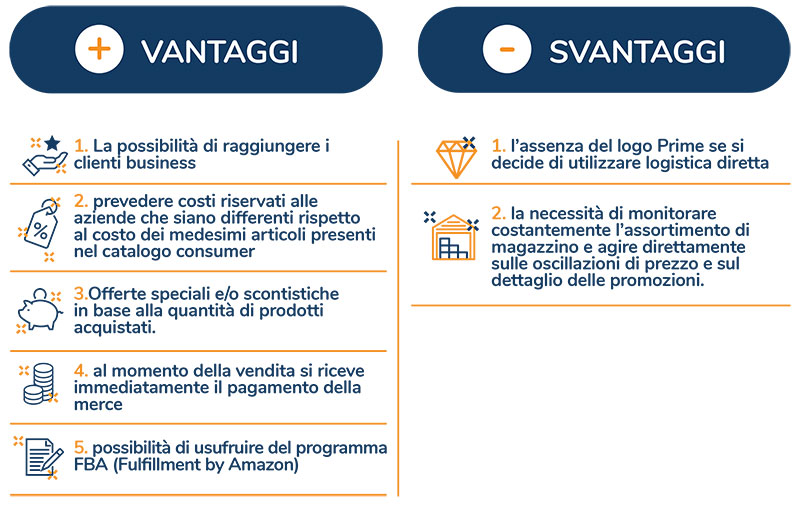Since 2018, Amazon Business has provided a specialized platform for business-to-business transactions, extending Amazon’s marketplace capabilities to serve companies, professionals, and organizations. This comprehensive platform offers tailored solutions for businesses ranging from individual professionals to large enterprises and public institutions, providing enhanced functionality and services specifically designed for B2B commerce.
Amazon Business represents a significant evolution in online B2B procurement, offering the convenience and efficiency of Amazon’s consumer platform while addressing the unique needs of business customers. The platform facilitates corporate purchasing with features such as:
- view prices net of VAT,
- set up multi-user accounts
- set custom spending limits
- use electronic invoicing
- take advantage of Prime’s benefits
Let’s see in detail how it works:
Creating an Amazon Business profile is free exactly as for its traditional version, you will clearly need to have a vat number or, alternatively, a business tax code. It is possible to create a dedicated account or convert the personal one. And it is also possible to create a multi-user account where, with the same login details, one can select whether to shop with the personal or the business profile, as needed, without the risk of confusing the areas.
In addition, the Amazon Business profile provides two levels of management:
- The Administrator, who visualizes all orders and manages users connected to the account, while granting relevant purchase approvals.
- The Purchasing manager, who places orders and sends approval requests to the Administrator.
Order numbers, project codes, or cost centers can also be entered at the purchasing stage. This mechanism simplifies approvals, tracking, and reconciliation of expenditures.

Products, in the business platform, are displayed already net of VAT, which allows you to quickly compare prices against other suppliers. In addition, for thousands of items, including those sold under the Amazon brand, you can automatically receive the electronic invoice in your inbox once the purchase is completed. For items for which an electronic invoice is not available, however, simply log into your profile and download it as a pdf. In any case, to facilitate the reconciliation of payments made, invoices show order numbers and data entered during purchase.
It is also important to remember that business users who have activated Amazon Prime on their personal profile, the benefits of which we have already discussed extensively in previous articles, will also be able to take advantage of it for their business profile. If, on the other hand, the business profile is not linked to any private profile, it will be enough to activate Amazon Prime for the business account at the standard cost of 36 euros per year, which includes up to 3 accounts; for more utilities the cost increases proportionally.
So far we have seen the benefits of Amazon Business for buyers. What are they, however, for those who sell? Is it really worth activating?
Let’s start by saying that selling on the Business version of Amazon is only possible for sellers in seller mode.
The possibility of reaching business customers is definitely the most interesting aspect for those thinking of approaching Amazon Business. More and more companies, in fact, seeing the convenience and efficiency of customer service decide to buy on the platform – only in 2015, when it was launched in the US, it registered more than 1mln business accounts (source: Amazon). This ensures that sellers potentially have a large user base. Consider, especially those who produce and distribute products for a Business to Business marketplace that usually needs targeted marketing strategies to reach new potential customers and has a very high cost per lead. With the right strategies in platform you can meet potential customers all over the world to whom you can propose your items. And to do this Amazon Business provides sellers with a number of very interesting possibilities. It is possible, in fact, to provide costs reserved for businesses that are different from the cost of the same items in the consumer catalog, special offers and/or discounts based on the quantity of products purchased. In this way, one can create one’s own commercial strategy in the platform exactly as one would do in the traditional sales channel.
Another element to consider is that, on Amazon Business, when the sale is made, payment for the goods is received immediately. This secures sellers from bad payer companies or the risk of delays to which offline sales, unfortunately, all too often expose them.
It is also important to note that even for Business sellers there is the possibility of taking advantage of the FBA (Fulfillment by Amazon) program, which we discussed in detail in the last article. This service allows, we remind you, to be able to devote time and energy to the strategic and commercial aspects, without having to worry about the logistical and customer service aspects that will be handled in the best possible way by Amazon.
Are there also disadvantages for those selling on Amazon Business?
The disadvantages for sellers are basically the same as those we have listed for private sellers with a seller profile, namely the absence of the Prime logo if you decide to use direct logistics and the need to constantly monitor the stock assortment and act directly on price fluctuations and the detail of promotions.

In conclusion, we can say that for a company interested in the b2b market, Amazon Business can be extremely interesting precisely because of the possibility of intercepting, through a single platform, a huge number of potential business customers. If one does not want to fall behind the competition, it is good to evaluate this channel because more and more companies in Italy, especially medium and small businesses, are choosing the convenience and convenience of making their purchases here. As we have seen for its traditional version, however, Amazon Business to be exploited to the fullest requires careful preliminary assessments of which products to target, calculate the margin net of platform fees, consider the possibility of customizing prices compared to competitors’ offerings, and apply the right positioning and promotion strategies.
